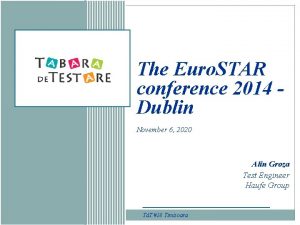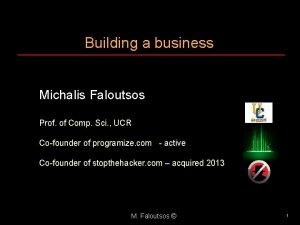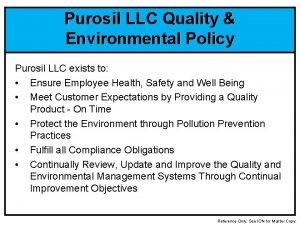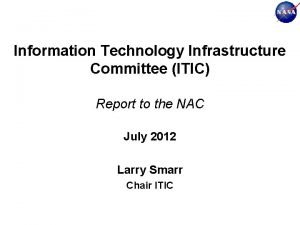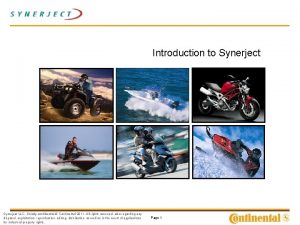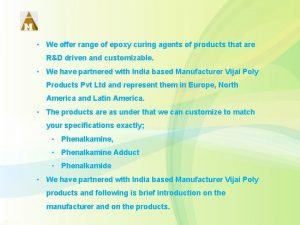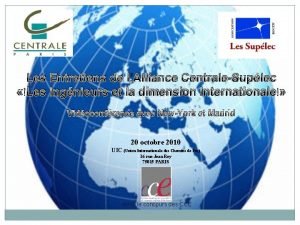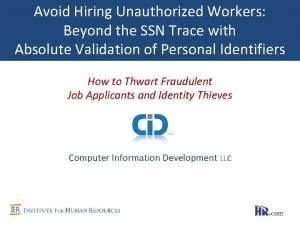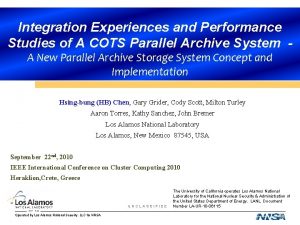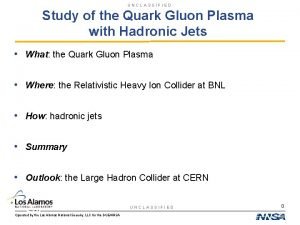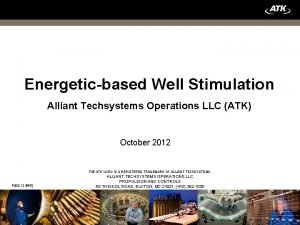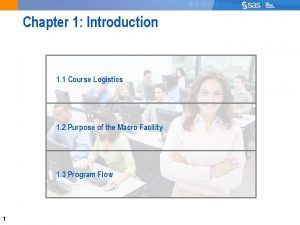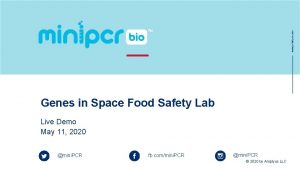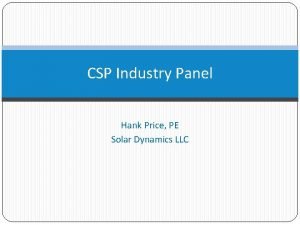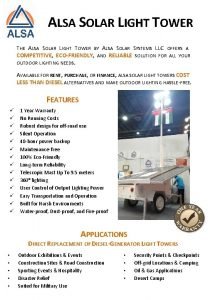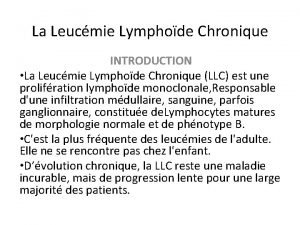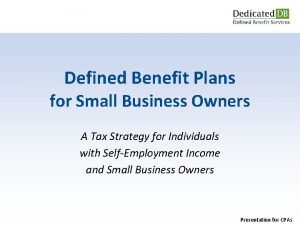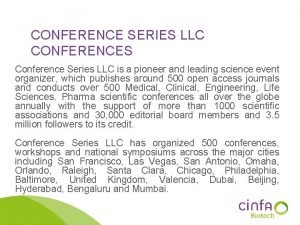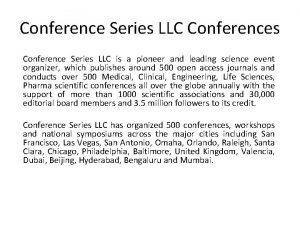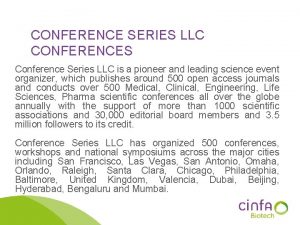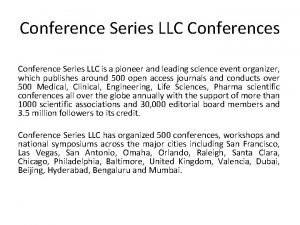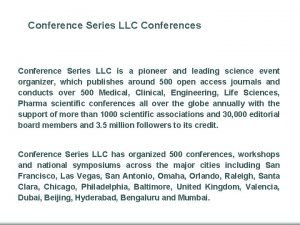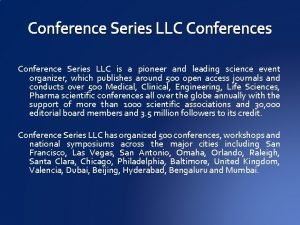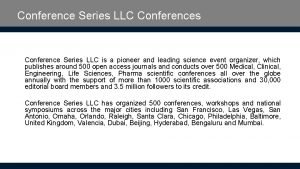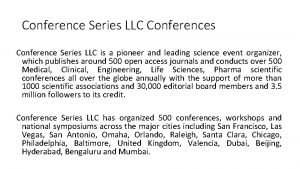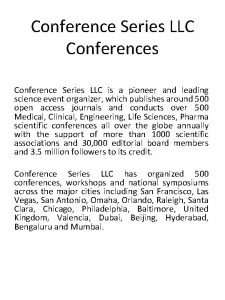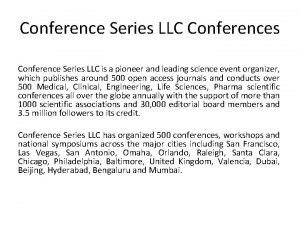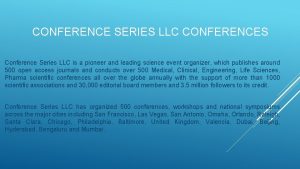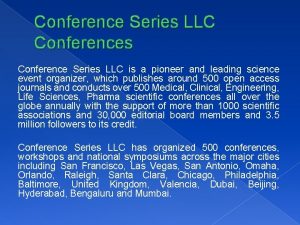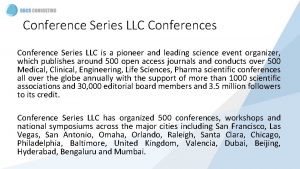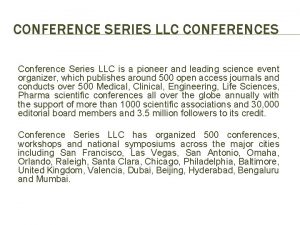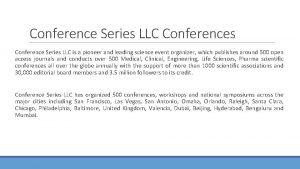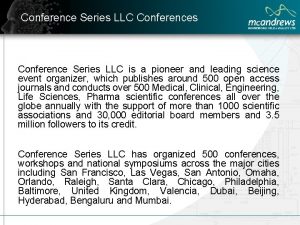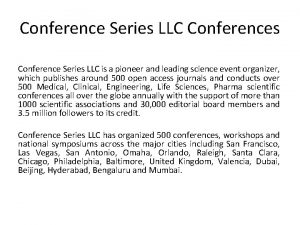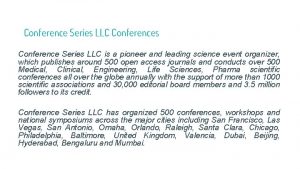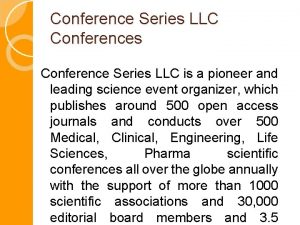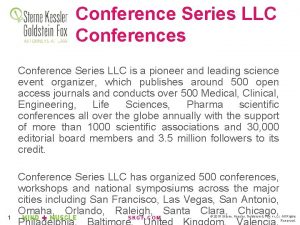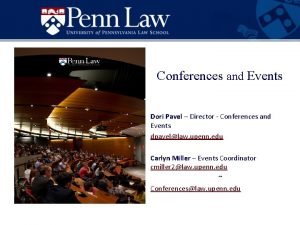CONFERENCE SERIES LLC CONFERENCES Conference Series LLC is







































- Slides: 39

CONFERENCE SERIES LLC CONFERENCES Conference Series LLC is a pioneer and leading science event organizer, which publishes around 500 open access journals and conducts over 500 Medical, Clinical, Engineering, Life Sciences, Pharma scientific conferences all over the globe annually with the support of more than 1000 scientific associations and 30, 000 editorial board members and 3. 5 million followers to its credit. Conference Series LLC has organized 500 conferences, workshops and national symposiums across the major cities including San Francisco, Las Vegas, San Antonio, Omaha, Orlando, Raleigh, Santa Clara, Chicago, Philadelphia, Baltimore, United Kingdom, Valencia, Dubai, Beijing, Hyderabad, Bengaluru and Mumbai. © SGS SA 2015 ALL RIGHTS RESERVED 1

MEETING REGULATORY CHARACTERIZATION EXPECTATIONS ESTABLISHING “FINGERPRINT-LIKE” BIOSIMILARITY - CRITICAL FIRST STEPS FOR BIOSIMILAR ASSESSMENT Dr Fiona M Greer Global Director, Bio. Pharma Services Development SGS Life Sciences Euro. Biosimilars 2016, 27 -29 June 2016 Valencia, Spain

AGENDA: MEETING REGULATORY ANALYTICAL CHARACTERIZATION EXPECTATIONS n What are the challenges and regulatory expectations associated with biosimilarity testing? n What analytical strategies can be used -which techniques, old & new, are suitable · Establishing the Quality Target Product Profile (QTPP) · Package of analytical tools/ battery of methods · Strategies for primary and higher order structure · Structure-function relationship © SGS SA 2015 ALL RIGHTS RESERVED 3

GLOBAL REGULATORY BACKGROUND EUROPE REST OF WORLD § 2005, EMEA guidelines on “Similar biological medicinal products”. Many updated since then. § Brazil, Australia, Turkey, Taiwan, Malaysia, Argentina, Mexico, Japan, Canada, S. A. and others have some form of pathway. § Approved 1 st Biosimilar in 2006, now has >20 including m. Abs. § Experienced regulators © SGS SA 2015 ALL RIGHTS RESERVED § Oct 2009, WHO “Guideline on Evaluation of Similar Biotherapeutic Products”. § Mar 2016, draft “Evaluation of m. Abs as SBPs” guideline. UNITED STATES § Biologics Price Competition and Innovation Act (BPCIA) Mar 23 rd 2010. New pathway-351(k) in PHS Act. § Feb 2012 -2015, FDA issued draft Guidances. Apr 2015 - finalized. § Mar 2015 - 1 st approval (Zarxio) § Apr 2016 - approval of Inflectra biosimilar of Remicade. 4

US REGULATORY PATHWAY (1/2) n 351(k) pathway requires comparison with a single reference product approved under the normal 351(a). The application must include information demonstrating biosimilarity based on data derived from: · Analytical studies demonstrating that the biological product is “highly similar” to the reference product notwithstanding minor differences in clinically inactive components · Animal studies and · A clinical study or studies n Two basic types of Biosimilar, from two steps: © SGS SA 2015 ALL RIGHTS RESERVED · Biosimilar - requires analytics (“highly similar”), preclinical & clinical (including immunogenicity) studies, any of which can be waived · Interchangeable Biosimilar – possible clinical “switching” studies 5

US REGULATORY PATHWAY (2/2) n FDA will consider the “totality of the data and information submitted” n Suggests the use of a “meaningful fingerprint-like analysis algorithm” n Statistical Analysis of Analytical Similarity Data: ranking QAs –Tiered approach. · 1. Critical- statistical equivalence test. Focus on a few high risk · 2. Less critical- quality ranges eg based on RP SDs. (Mean +/- XSD) · 3. Least – raw/graphical comparisons Steven Kozlowski, M. D. Director, Office of Biotechnology Products OPS/CDER/US FDA © SGS SA 2015 ALL RIGHTS RESERVED 6

US REGULATORY PATHWAY (2/2) n FDA will consider the “totality of the data and information submitted” n Suggests the use of a “meaningful fingerprint-like analysis algorithm” n Statistical Analysis of Analytical Similarity Data: ranking QAs –Tiered approach. · 1. Critical- statistical equivalence test. Focus on a few high risk · 2. Less critical- quality ranges eg based on RP SDs. (Mean +/- XSD) · 3. Least – raw/graphical comparisons Steven Kozlowski, M. D. Director, Office of Biotechnology Products OPS/CDER/US FDA © SGS SA 2015 ALL RIGHTS RESERVED 7

BIOSIMILARS DEVELOPMENT PARADIGM 351(a) BLA 351(k) BLA ADDITIONAL CLINICAL STUDIES *** CLINICAL S&E. * CLIN. PHARM. PK/PD CLIN. PHARM. NON-CLINICAL INITIAL CLINICAL STUDIES ** NON-CLINICAL ANALYTICAL * Pivotal ANALYTICAL **Pivotal in biosimilar development ***Confirmatory, as needed Adapted from Emily Shacter, “Current Regulatory and Scientific Issues with Biosimilars in the US; CHI Biotherapeutics Analytical Summit, 13 March 2015, Baltimore, MD © SGS SA 2015 ALL RIGHTS RESERVED 8

A STEPWISE APPROACH n Analytical comparison to reference product · Structure · Function n Non-clinical testing n Clinical evaluation in intended population Published in: Mark A Socinski; Giuseppe Curigliano; Ira Jacobs; Barry Gumbiner; Judith Mac. Donald; Dolca Thomas; m. Abs 2015, 7, 286 -293. © SGS SA 2015 ALL RIGHTS RESERVED Each step supported by previous one. 9

WHEN IS ANALYTICAL CHARACTERIZATION REQUIRED? © SGS SA 2015 ALL RIGHTS RESERVED 10

MEETING REGULATORY CRITERIA FOR BIOSIMILARITY DEMONSTRATION n The development of a biosimilar product requires comprehensive physicochemical structural characterization of the (glyco)protein at MANY stages. n Initially, batches of the originator molecule are studied to determine the exact protein sequence, post-translational modifications and variability of quality attributes. These data form the Quality Target Product Profile (QTPP) for the biosimilar. n At early stage, characterization surveys may help to guide choice of an appropriate cell line. Build similarity concept. © SGS SA 2015 ALL RIGHTS RESERVED 11

COMPARISON OF THE BIOSIMILAR SIDE-BY-SIDE WITH THE ORIGINATOR n “Comparability” · Comparable to Reference Product · Determine if proteins have the same biochemical, biophysical and physiological attributes · Product related variants and impurities STAGE 3 n n Choice of reference material Batches of Biosimilar vs batches of Originator Changes in Originator product Strategies for Primary and Higher Order Structure-battery of physicochemical analytical techniques with appropriate sensitivity n Which techniques to utilise? “Fingerprinting” © SGS SA 2015 ALL RIGHTS RESERVED 12

REVISED EMA QUALITY GUIDELINE: COMPARABILITY EXERCISE EMA/CHMP/BWP/247713/2012 Revision 1, Effective 1 Dec 2014 n Use state-of-art analytical, orthogonal methods n Comparative characterization studies should include assessment of composition, physical properties, primary & higher order structures, purity, product-related substances (e. g. isoforms) and impurities, and biological activity with “sufficiently sensitive analytical tools” n Quantitative ranges for quality attributes established n Use material from final process for clinical trials (i. e. avoid additional comparability exercises) n Suitability of the formulation should be demonstrated (need not be identical) © SGS SA 2015 ALL RIGHTS RESERVED 13

WHY ARE BIOPRODUCTS A CHALLENGE ? Acetylation Acylation Amidation (deamidation) Carbamylation Carboxylation Formylation Glycosylation Methionine Oxidation Norleucine Phosphorylation Sulphation During/ after translation of the oligonucleotide code into an AA sequence, processing events occur to confer biological activity. These Co- and Post-Translational events change the primary structure but are NOT predictable from the gene sequence. So it is essential to study the expressed protein products not the genes. Carbohydrate is a source of product heterogeneity. Glycoproteins are mixtures of glycoforms i. e. the same polypeptide but different sugars. © SGS SA 2015 ALL RIGHTS RESERVED 14

EXAMPLE OF COMPLEXITY: ANTIBODY CASE · Mass spectrometry of intact protein and released L &H chains · Amino Acid Composition Analysis · N- and C-terminal sequencing · Peptide “MAPPING” Analysis (Sequence coverage: 100% LC and 100% HC) · Monosaccharide and sialic acid analysis · Oligosaccharide population analysis · SDS-PAGE analysis · Circular Dichroism · Analytical Ultracentrifugation © SGS SA 2015 ALL RIGHTS RESERVED 15

WHAT REGULATIONS COVER PHYSICOCHEMICAL CHARACTERIZATION? n ICH Topic Q 6 B “Specifications: Test Procedures and Acceptance Criteria for Biotechnological/Biological Products” n Structural characterization and confirmation 1. 2. 3. 4. 5. 6. Amino acid sequence Amino acid composition Terminal amino acid sequence Peptide map Sulfhydryl group(s) and disulfide bridges Carbohydrate structure n Physicochemical properties 1. 2. 3. 4. 5. 6. © SGS SA 2015 ALL RIGHTS RESERVED Molecular weight or size Isoform pattern Extinction coefficient Electrophoretic pattern Liquid Chromatographic pattern Spectroscopic profiles 16

POTENTIAL ANALYTICAL TOOLS n Amino acid sequence and modifications: Mass Spectrometry (MS), peptide mapping, chromatography n Glycosylation: Anion exchange, enzymatic digestion, peptide mapping, Capilary Electrophoresis, MS n Folding: MS S-S bridge determination, calorimetry, Hydrogen. Deuterium exchange (HDX) and ion mobility MS (IM-MS), Nuclear Magnetic Resonance (NMR), circular dichroism, Fourier transform spectroscopy, fluorescence n PEGylation & isomers: chromatography, peptide mapping n Aggregation: Analytical ultracentrifugation, size-exclusion chromatography SEC-MALS, field flow fractionation (A 4 F), light scattering DLS, microscopy, Transmission Electron Microscopy (TEM) n Proteolysis: electrophoresis, chromatography, MS n Impurities: proteomics, immunoassays, metal & solvents analysis n Subunit interactions: chromatography, ion mobility MS n Heterogeneity of size, charge, hydrophobicity: Chromatography; gel & capillary electrophoresis, light scattering, IM-MS, CESI-MS © SGS SA 2015 ALL RIGHTS RESERVED 17

INTACT MASS MEASUREMENT- MONITORING GLYCOSYLATION © SGS SA 2015 ALL RIGHTS RESERVED 18

INTACT MASS COMPARISON OF THREE BIOSIMILAR MABS © SGS SA 2015 ALL RIGHTS RESERVED 19

PEPTIDE MAPPING WORKFLOW © SGS SA 2015 ALL RIGHTS RESERVED 20

HOW CAN MS PROVIDE ANALYTICAL DATA FOR ANTIBODY CHARACTERIZATION? · Mass spectrometry of intact protein and released L &H chains · Amino Acid Composition Analysis · N- and C-terminal sequencing · Peptide “MAPPING” Analysis (Sequence coverage: 100% LC and 100% HC) · Monosaccharide and sialic acid analysis · Oligosaccharide population analysis · SDS-PAGE analysis · Circular Dichroism · Analytical Ultracentrifugation © SGS SA 2015 ALL RIGHTS RESERVED 21

INTACT MASS MEASUREMENT-MONITORING GLYCOSYLATION © SGS SA 2015 ALL RIGHTS RESERVED 22

INTACT MASS COMPARISON OF THREE BIOSIMILAR MABS © SGS SA 2015 ALL RIGHTS RESERVED 23

PEPTIDE MAPPING WORKFLOW © SGS SA 2015 ALL RIGHTS RESERVED 24

ANTIBODY ANALYSIS – GENERAL WORKFLOW © SGS SA 2015 ALL RIGHTS RESERVED 25

SULFHYDRYL GROUP(S) AND DISULFIDE BRIDGES © SGS SA 2015 ALL RIGHTS RESERVED 26

GLYCOSYLATION CHARACTERIZATION Structural characterisation and confirmation of carbohydrate. For glycoproteins, the following should be determined: n Carbohydrate content (neutral sugars, amino sugars and sialic acids) n Structure of the carbohydrate chains, the oligosaccharide pattern, the antennary profile, linkage n Glycosylation site(s) on the protein chain © SGS SA 2015 ALL RIGHTS RESERVED 27

ANALYSIS OF GLYCOPROTEINS © SGS SA 2015 ALL RIGHTS RESERVED 28

ANALYSIS OF GLYCOPROTEINS Anomeric specific Intermonosaccharide Linkages Glycan Profile MALDI-MS HPAEC-PAD Heterogeneity & Extent of Glycosylation Intact mass vs. Deglycosylated ES-MS / MALDI-MS Glycoprotein Quantitative Monosaccharide Composition GC-MS Glycopeptides Quantitative Sialic Acid Content Qualitative Site-specific Glycosylation HPAEC-PAD © SGS SA 2015 ALL RIGHTS RESERVED Peptide mapping LC-ES-MS MALDI-MS Glycan Sequence Native Glycans Sample Glycan Composition MALDI-MS/MS Derivatised Glycans Antennary Profile ESI-MS Intermonosaccharide Linkages PMAA GC-MS Quantitative Glycan profile 2 AB-LC-MS 29

BIOPHYSICAL TECHNIQUES FOR HIGHER ORDER STRUCTURE & CONFORMATION TECHNIQUE REPORTS ON ADVANTAGES DISADVANTAGE S Secondary/ Tertiary Structure Quantitative Sensitive to helix content FTIR Secondary Structure Quantitative Sensitive to sheet content Less prone to buffer interference Intrinsic Fluorescence Local Tertiary Structure Sensitive Potential for moderate HTP Qualitative Surface Hydrophobicity Sensitive Ensemble tertiary structure-no local Potential for moderate HTP Qualitative Local Tertiary Structure Simultaneous to concentration determination Potential for moderate HTP Qualitative Circular Dichroism Extrinsic Fluorescence UV-VIS (2 ndderivative) Screening method formulation (HTP) Qualitative Dynamics, conformation, interactions Automation has improved throughput. Cost, data processing 3 D Structure Elucidation More resolving than 1 D Differential Scanning Calorimetry Thermal Stability HDX-MS 2 D Protein NMR © SGS SA 2015 ALL RIGHTS RESERVED Formulation buffers can interfere 30

BIOPHYSICAL TECHNIQUES FOR AGGREGATION TECHNIQUE REPORTS ON ADVANTAGES DISADVANTAGES SDS PAGE Aggregates Inexpensive Low throughput SV-AUC Oligomers/ aggregates Matrix free, quantitative, resolution Slow, low throughput, estimated m. wts DLS HMW aggregates Matrix free, sensitivity, moderate for HTP Poor resolution, qualitative SEC-MALS Oligomers/ aggregates Direct MW determination, Matrix present rapid analysis, High shear forces quantitative Macromolecule size distribution Non-column separation with high resolution FFF © SGS SA 2015 ALL RIGHTS RESERVED 31

BIOLOGICAL/FUNCTIONAL ASSAYS - WHY? “Any differences in higher order structure between a proposed product and a reference product should be evaluated in terms of a potential effect on protein function and stability. Thus, functional assays are also critical tools for evaluating the integrity of the higher order structures. ” “The stepwise approach should start with extensive structural and functional” “Extensive, robust comparative physicochemical and functional studies (these may include biological assays, binding assays, and enzyme kinetics) should be performed to evaluate whether the proposed product and the reference product are highly similar. ” © SGS SA 2015 ALL RIGHTS RESERVED “As a scientific matter, the type of bridging data needed will always include data from analytical studies (e. g. , structural and functional data) that directly compares all three products (i. e. , the proposed product, the U. S. -licensed reference product, and the non-U. S. -licensed comparator product)“ n Scientific Considerations in Demonstrating Biosimilarity to a Reference Product (FDA – 2015) n Quality Considerations in Demonstrating Biosimilarity of a Therapeutic Protein Product to a Reference Product (FDA – 2015) “Multiple functional assays should, in general, be performed as part of the analytical similarity assessments”. 32

FUNCTIONAL ASSAYS Q 6 B Potency : “the measure of the biological activity using a suitably quantitative biological assay, based on the attribute of the product which is linked to the relevant biological properties. ” and Biological Activity as “the specific ability or capacity of the product to achieve a defined biological effect” • • Cell culture-based Biological Assay Biochemical Assays © SGS SA 2015 ALL RIGHTS RESERVED n Cell Uptake n Proliferation n Cytotoxicity n Secondary Messenger n PCR Based Functional Assays n Enzymatic Assays n Ligand Binding n Immunoassays n RIA 33

BIOASSAYS CRITICAL FOR DEMONSTRATING BIOSIMILARITY n Fc Domain Functional Assays • ADCC • CDC • Whole Blood n Fab Domain • Neutralization • Receptor activation • Receptor blockade n Target binding n Binding n FcγR n Fc. Rn n complement © SGS SA 2015 ALL RIGHTS RESERVED 34

REAL EXAMPLE: SANDOZ ZARXIO (EP 2006) ANALYTICAL METHODS cf. US & EU NEUPOGEN © SGS SA 2015 ALL RIGHTS RESERVED 35

EXAMPLE 2: CELLTRION REMSIMA (INFLIXIMAB) ANALYTICAL METHODS PRIMARY STRUCTURE HOS GLYCOSYLATION PURITY/ IMPURITY CHARGED ISOFORMS PEPTIDE MAPPING (HPLC) FTIR OLIGOSACC. PROFILE SEC-HPLC IEF PEPTIDE MAPPING (LC-MS) DSC N-LINKED GLYCAN SEC-MALS IEC-HPLC INTACT MASS (LCMS) CD SIALIC ACID ANALYSIS AUC MONOSACC. ANALYSIS CE-SDS (RED/NON) AAA/MOLAR ABSORPTIVITY FREETHIOL &S-S N-TERM SEQUENCE ANTIBODY ARRAY C-TERM SEQUENCE X-RAY CRYSTALLOGRAPHY © SGS SA 2015 ALL RIGHTS RESERVED 36

RE-CAP: ANALYTICAL CHARACTERIZATION DATA FOR BIOSIMILARS n Development of a Biosimilar requires comprehensive physicochemical structural characterization at MANY stages. n Initially, batches of originator are studied to determine the exact protein sequence, PTMs and variability of quality attributes. These data form the Quality Target Product Profile (QTPP). n Various regulatory guidelines then require side-by-side comparative data to demonstrate “Biosimilarity”. n MS techniques are applicable at all stages, but essential for determination of originator sequence. Advances in instrumentation and Proteomic/Glycomic strategies enable rapid identification of QTPP. n Multiple orthogonal analytical methods are used to define “fingerprint” comparison. n Increasing importance on HOS techniques to link with biological activity. © SGS SA 2015 ALL RIGHTS RESERVED 37

THANK YOU FOR YOUR ATTENTION Life Sciences Fiona Greer Global Director, Bio. Pharma Services Development SGS M-Scan Ltd 2 -3 Millars Business Centre, Fishponds Close, Wokingham Berkshire, RG 41 2 TZ, UK Phone: +44 (0) 118 989 6940 Fax: +44 (0) 118 989 6941 E-mail : fiona. greer@sgs. com Web : www. sgs. com/biosimilars + 41 22 739 9548 + 1 866 SGS 5003 + 65 637 90 111 + 33 1 53 78 18 79 + 33 1 41 24 87 87 + 1 877 677 2667 © SGS SA 2015 ALL RIGHTS RESERVED 38

LET US MEET AGAIN. . We welcome you to our future conferences of Conference Series LLC through 6 th International Conference and Exhibition on Biologics and Biosimilars October 19 -21, 2016 Houston, TX, USA © SGS SA 2015 ALL RIGHTS RESERVED 39
 Star conferences inc
Star conferences inc As a result of the yalta and potsdam conferences, ________.
As a result of the yalta and potsdam conferences, ________. Mice
Mice All three round table conference
All three round table conference Organizing seminars and conferences
Organizing seminars and conferences Series aiding and series opposing
Series aiding and series opposing Maclaurin polynomial
Maclaurin polynomial Arithmetic series formula
Arithmetic series formula Maclaurin series vs taylor series
Maclaurin series vs taylor series Ibm p series
Ibm p series Balmer series lyman series
Balmer series lyman series Amount of feedback
Amount of feedback Taylor series of composite functions
Taylor series of composite functions Jaal, llc
Jaal, llc Star feeders
Star feeders Purosil llc
Purosil llc Ipost progress llc
Ipost progress llc Synerject llc
Synerject llc Epoxy phenalkamine coatings
Epoxy phenalkamine coatings Bobbi buell
Bobbi buell Centralesuplec
Centralesuplec Washington cpa services llc
Washington cpa services llc Cpn ssn validator
Cpn ssn validator Treewalker, llc
Treewalker, llc Qgp llc
Qgp llc Plexos api
Plexos api Alliant techsystems operations llc
Alliant techsystems operations llc Token logistics llc
Token logistics llc Apelles, llc
Apelles, llc Hire quest, llc
Hire quest, llc Amplyus llc
Amplyus llc Hidden pivots llc
Hidden pivots llc Csp
Csp Slt 800 solar light tower factories
Slt 800 solar light tower factories Leucmie
Leucmie Systech intl llc
Systech intl llc Nitin group
Nitin group Dedicated defined benefit services
Dedicated defined benefit services Plankey air llc
Plankey air llc Customer experience solutions llc
Customer experience solutions llc
